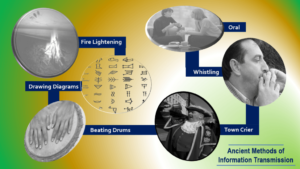Back to: Computer Studies JSS1
Welcome to class!
In today’s class, we shall be talking about fire lightning as an ancient method of transmitting information. Please enjoy the class!
Ancient Methods of Transmitting Information – fire lighting

Before the advent of modern communication technologies, humans relied on ingenious methods to transmit information over long distances. One such method was the use of fire lighting. This seemingly simple practice served as a powerful tool for communication in various contexts, from sending warnings to guiding travelers.
Types of Fire Signals:
![]()
Smoke Signals: Smoke produced by controlled fires could be manipulated to convey different messages. The number, color, and arrangement of smoke plumes carried specific meanings understood by those familiar with the code. For instance, a single column of white smoke might signify peace, while multiple black plumes could indicate danger.
Flames: The size and color of flames could also be used to transmit information. Additionally, strategically placed fires could be visible at night, allowing for communication over greater distances.
Bioluminescence: In some cases, people even utilized naturally occurring bioluminescent organisms, such as fireflies, to send messages. These organisms would be released into the night sky, creating a visible display that could be interpreted by observers.
Applications of Fire Lighting:

Military: Armies used fire signals to coordinate troop movements, issue warnings, and announce victories.
Navigation: Fire beacons were constructed on hilltops and coastlines to guide travelers and warn them of hazards.
Hunting: Hunters used fire to signal their success or location to other members of their group.
Religious Ceremonies: Fire played a significant role in religious rituals and ceremonies, often used to communicate with deities or appease spirits.
Advantages:
Simple and reliable: Fire lighting required minimal technology and could be used effectively even in difficult conditions.
Visible from long distances: Smoke and flames were easily visible from afar, allowing for communication over large areas.
Flexible and adaptable: The meaning of fire signals could be adapted to different contexts and situations.
Limitations:
Dependent on weather conditions: Wind and rain could affect the visibility of smoke and flames, hindering communication.
Limited range: Fire signals could only be seen from a certain distance, restricting their effectiveness.
Limited message complexity: The complexity of information that could be transmitted through fire signals was constrained by the available symbols and their interpretations.
Despite its limitations, fire lighting served as a vital communication tool for ancient societies. It facilitated information sharing, coordination, and survival in a world without modern technology. Understanding these early methods of information transmission allows us to appreciate the ingenuity and resilience of human societies throughout history.
We have come to the end of today’s class. I hope you enjoyed the class!
In the next class, we shall be discussing Ancient Methods of Transmitting Information – town crying and whistling.
In case you require further assistance or have any questions, feel free to ask in the comment section below, and trust us to respond as soon as possible. Cheers!
Question Time:
- How did different types of fire signals (smoke, flames, bioluminescence) function?
- What were some specific ways fire signals were used in ancient societies (military, navigation, religious ceremonies)?
- What were the advantages and limitations of using fire lighting for communication?
